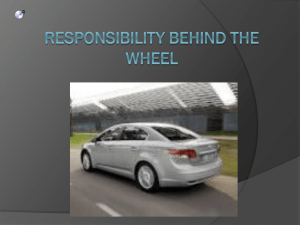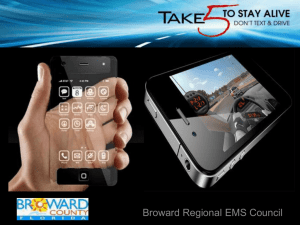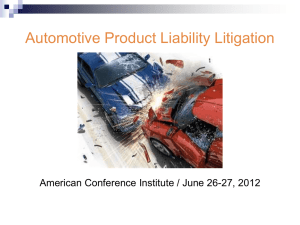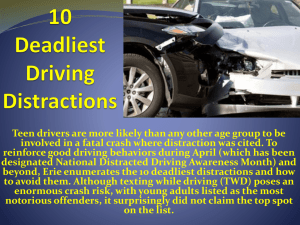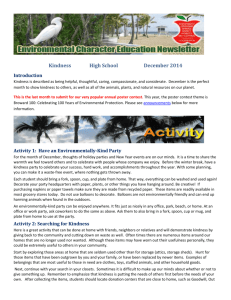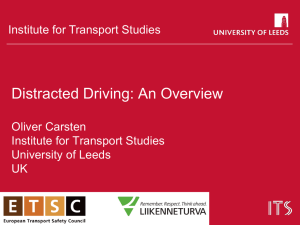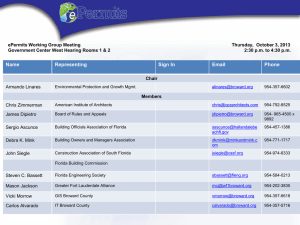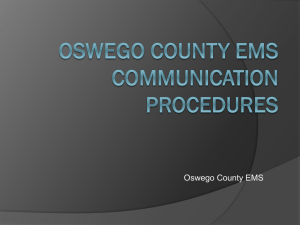Don`t Text and Drive Take 5 - Plantation General Hospital
advertisement
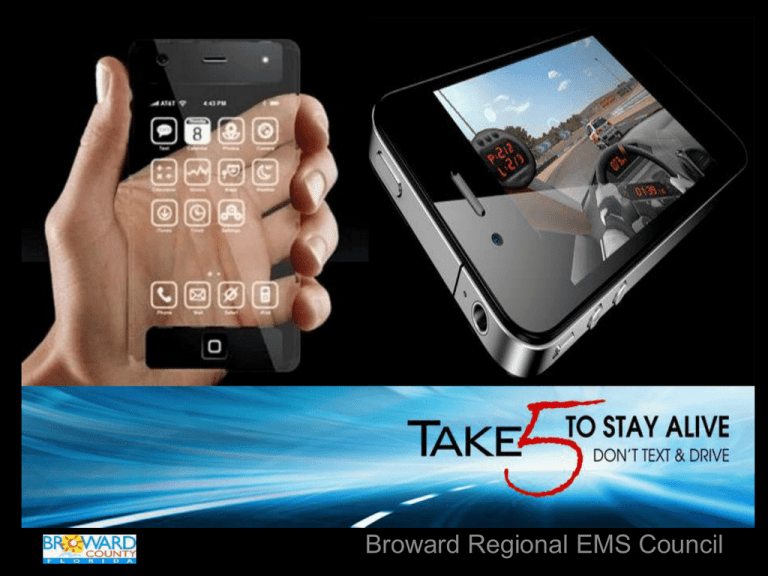
+ Broward Regional EMS Council Objectives Objectives Define Distracted Driving Review distractive behaviors exhibited by drivers Discuss how the behaviors affect our response to driving Identify the at-risk population(s) and the behaviors that can be attributed to the group Discuss how legislature is dealing with the problem Review prevention strategies for implementation Background Each day, more than 15 people are killed and more than 1,200 people are injured in crashes that were reported to involve a distracted driver National Highway Traffic Safety Administration, 2009 Broward Regional EMS Council Distracted driving is any activity that could divert a person's attention away from the primary task of driving. They include: Texting, using a cell phone or smartphone. Eating, drinking, or Reading (including maps), using a navigation system. Watching player. grooming. videos, adjusting a radio, CD player, or MP3 Why Do They Do It? “Right now” mentality Increased stress levels Technological Advances Smart Phones PDA GPS MP3 Mini Television/CD Look Who’s Talking 25% of drivers admit to talking on the cell phone regularly, while driving. 18-29 years old – 39% 30-39 years old – 39% 40-49 years old – 37% 50-59 years old – 18% 60+ years old – 8% 34% admit to rare cell phone use. National Safety Council 2010 Broward Regional EMS Council In 2009, 5,474 people were killed in crashes involving driver distraction, and an estimated 448,000 were injured.* 16% of fatal crashes in 2009 involved distracted driving.* 20% of injury crashes in 2009 involved distracted driving. * In the month of June 2011, more than 196 billion text messages were sent or received in the US. Up nearly 50% from June 2009. ** • Courtesy NHTSA • ** Courtesy CTIA Broward Regional EMS Council Texting is the most dangerous distraction because it involves manual, visual, and cognitive distractions simultaneously. Sending or reading a text takes your eyes off the road for 4.6 seconds. At 55 mph, that's like driving the length of an entire football field, blindfolded. A majority of people admit to awareness of the hazards relating to texting or talking while driving. What Studies Show About Cell Phones Drivers talking on cell phones = 18 percent slower braking than other motorists. Talking on a cell phone while driving = impaired with a blood alcohol level of 0.08 percent. Texting drivers were six times more likely to crash than someone who was not texting. Photo courtesy Plantation Fire Department Site University of Utah Study, 2009 Broward Regional EMS Council Teen drivers are more likely than other age groups to be involved in a fatal crash where distraction is reported. In 2009, 16% of teen drivers involved in a fatal crash were reported to have been distracted. (NHTSA) 40% of all American teens say they have been in a car when the driver used a cell phone in a way that put people in danger. (Pew) Drivers who use hand-held devices are 4 times more likely to get into crashes serious enough to injure themselves. (Monash University) Text messaging creates a crash risk 23 times worse than driving while not distracted. (VTTI) Manual ~ Visual ~ Cognitive Manual : Taking hands off the steering wheel to manipulate a device Visual : Looking away from roadway to visually obtain data Reading electronic mail, texts Making phone calls Choosing music on MP3 Locating item in car Manual ~ Visual ~ Cognitive Cognitive: mental workload associated with a task that involves thinking about something other than the driving task Impacts a wide range of behaviors, such as a significant reduction in response time and an increased crash risk. You’re four times It’s hard to more likely to concentrate on have a crash two things when you’re on at the same time. a mobile phone. What Causes this Impairment? Multi-tasking: A Drain on the Brain Brain handles tasks sequentially Brain switches between one task and another Brain filters out information due to overload Drivers miss critical information Source: National Institute of Health Multitasking: A Brain Drain Brain power used while driving decreases by 40% when a driver listens to conversation or music Functional MRI Study, Center for Cognitive Brain Imaging at Carnegie Mellon University Study, 2009 Inattention Blindness Type of cognitive distraction “looking” but not “seeing” Doing two cognitively complex tasks (driving and using cell phone); brain shifts focus Hands-free drivers LESS likely to see: High and low relevant objects Visual cues Exits, red lights and stop signs Navigational signage Content of objects National Safety Council 2010 Broward Regional EMS Council Headset cell phone use is not substantially safer than hand-held use. (VTTI) Using a cell phone while driving - whether it's handheld or hands-free delays a driver's reactions as much as having a blood alcohol concentration at the legal limit of .08 percent. (University of Utah) Driving while using a cell phone reduces the amount of brain activity associated with driving by 37%. (Carnegie Mellon) Broward Regional EMS Council Many states including DC have banned text messaging while driving. Twelve of these laws were adopted in 2010 alone. Secondary offense in Florida “Stupid Is As Stupid Does” Forrest Gump’s Mother WM-01 - Wheelmate Steering Wheel Desk Tray - Gray 5 out of 5 stars - 2 customer reviews Comment/Review: Thank you! Thank you! Now I have the ability to focus on what is really important while driving...My McTriple sandwich and fries. I was so tired of having to use the drive thru bag as my table. Whew! Steering Wheel Desk/Tray/Table... you complete me. What Can We Do? Start with you and your home - Educate Phone Applications aimed at preventing distracted driving Sprint – Drive First Program, subscription based (not an app), detects when phone in moving vehicle – locks screen; incoming calls are routed to voice mail and texts are auto-replied AT&T – Drive Mode App –curbs the urge to text T-Mobile – Drive Smart; Drive Smart Plus, subscription based; blocks texting while driving Public awareness campaign Involvement with professional organization (Like BENA) and legislation Broward Regional EMS Council The purpose of the “Take 5 to Stay Alive” campaign, sponsored by the Broward Regional EMS Council, is to improve roadway safety by preventing crashes related to the act of text messaging. “Take 5 to Stay Alive” is simple to do and can save your life. Take a break from driving and pull off the road to use your cell phone Introducing Program Gabby Chaves Spokesperson 18 Years Old Western High School Honor Student Indy Lites Race Car Driving Champion Broward Regional EMS Council Broward.org/Take5 References National Highway Traffic Safety Administration. Traffic Safety Facts: Distracted Driving 2009. Washington, DC: US Department of Transportation, National Highway Traffic Safety Administration, September, 2010. Publication no. DOT-HS-811-379. http://www.flsenate.gov/Session/Bills http://www.nsc.org/safety_road/Distracted_Driving http://distraction.gov/campaign-tools/ http://www.unews.utah.edu/old/p/121809-3.html http://hfs.sagepub.com/content/51/5/762.refs.html
